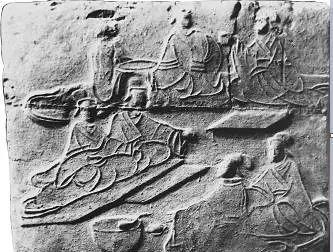Nowadays, at banquets, before entering the table, the host invites guests to sit down as a sign of respect. This kind of etiquette is exactly the legacy of the ancient people's courtesy system two or three thousand years ago.
In ancient times, on the indoor floor, it was often necessary to lay a layer of mats woven with bamboo grates, called feasts. Another layer of mats made of grass and the like on the feast is called a mat, which is used to prevent moisture. When people enter the house, they sit on the upper floor of the seat, so it is called sitting on the floor. The feast is only one layer, and the mats can be laid on multiple floors. According to ancient records, the seat of the Son of Heaven was to be paved on five floors.
The seats are woven into rectangular shapes and spread horizontally on the feast. Usually there is no fixed laying, it can be moved as the situation. When a banquet is to be held, it is changed according to the number of people in the table or the status of the guests, which is called "cloth seat". When the table is clothed, a few of different lengths are placed in front of the table to place food. Drinkers sit close to each other. The "Poetry Sutra Daya Xingwei" has the sentence "Setting up a banquet at a banquet", which is to change the usual laying method and readjust it. The "Poetry Sutra Xiao Ya Bin's First Feast" writes that "the first feast of the guest, the left and right ranks" refers to the guests sitting on the table, and the people on the left and right sides are seated in order (young and old). It shows that the seats are dignified and inferior, elderly and young, that is, according to the upper and lower, left and right.
The "Li Ji Qu Li Shang" records that "Xi Nan Xiang (Xiang) and Bei Xiang are the upper to the west; East Township and Xi Xiang are to the south as the upper.". If the north and south seats are opposite, the west end of the seat must be the top and the east end. The east and west seats are opposite, and the south end of the seat must be the upper and the north end. The so-called "up", that is, the upper seat, refers to the end of the seat, "down", that is, the lower seat, refers to the end of the seat. The end of the seat is the seat of his Holiness the Elder, and at the end of the seat is the seat of the lowly. Therefore, the "Book of Etiquette" also clearly pointed out: "If there is no upper and lower seat, it is chaotic on the table." "As soon as the seat is chaotic, it is impossible to distinguish between the elder and the young.

A picture of a feast on a portrait brick
In the Han Dynasty, the arrangement of the number of honorable and inferior long and low seats at the banquet was changed, and the four directions of the seat were divided up and down: the east direction was up, the south direction was secondary, the north direction was again, and the last was the west direction, usually as a companion seat. Sima Qian, in the "Records of History", noticed this, and in a passage writing about the Feast of Hongmen, he specifically recorded in detail the seat that Xiang Yu had arranged for Liu Bang to sit on the table: "King Xiang and Xiang Bodong sat in the east direction, Fan Zeng sat in the south direction, Pei Gong sat in the north direction, and Zhang Liangxi sat in the service." "According to common sense, Xiang Yu set up a banquet, and Liu Bang was an invited guest and should stay above (eastbound). However, Xiang Yu (the master) just sat eastward for himself, placing Xiang Bo and Fan Zeng in the honorable position, Liu Bang instead relegated to the second position, and Zhang Liang actually sat with him. This arrangement clearly portrayed Xiang Yu's arrogant attitude.
Shandong Zhucheng Han portrait stone feast and drinking map
The ancients sat down, not only to divide up and down, but also have many regulations. Mentioned in the Book of Rites alone are "different seats for fathers and sons", "different seats for men and women", "seats for those who are worried about sitting on the side", "special seats for the bereaved" and so on. These rituals, in later times, were gradually abolished and were less exquisite.
◎ This article is excerpted from "Visible Life of ancients" (author Zhu Qixin), the source network, the copyright of the picture and text belongs to the original author.